|
FAQs about the Diseases
of Clownfishes
25
Related FAQs: Clownfish Disease 1, Diseases of Clownfishes 2, Diseases of Clownfishes 3, Clownfish Disease 4, Clownfish Disease 5, Clownfish Disease 6, Clownfish Disease 7, Clownfish Disease 8, Clownfish Disease 9, Clownfish Disease 10, Clownfish Disease 11, Clownfish Disease 12, Clownfish Disease 13, Clownfish Disease 14, Clownfish Disease 15, Clownfish Disease 16, Clownfish Disease 17, Clownfish Disease 18, Clownfish Disease 19, Clownfish Disease 20, Clownfish Disease 21, Clownfish Disease 22,
Clownfish
Disease 23, Clownfish Disease 24,
Clownfish Disease 26,
Clownfish Disease 27,
& FAQs on
Clownfish Disease By: Environmental
Stress, Nutrition, Social/Behavioral/Territoriality, Trauma/Mechanical Injury, & Pathogens:
Lymphocystis, Infectious Disease (Bacteria, Fungi...),
Protozoans: Cryptocaryon/Ich,
Amyloodinium/Velvet, Brooklynella (see article below), &
Mysteries/Anomalous Losses, Cure, Success Stories, & Clownfishes in General, Clownfish Identification, Clownfish Selection, Clownfish Compatibility, Clownfish Behavior, Clownfish Systems, Clownfish Feeding, Clownfishes and Anemones,
Breeding
Clowns,
Related Articles: Clownfish Disease, Clownfishes, Maroon
Clowns, Marine Disease, Brooklynellosis,
|
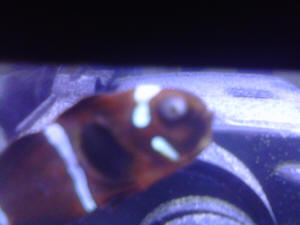
|
|
Clownfish (& more) trouble 12/29/12
Hello, we have a new
<... how new?>
saltwater tank 35 g, with live rock and sand. One of the
rocks had a small anemone on it. We don't know what type. The tank had
been set up and running for about a year when we bought it. We recently
added 2 damsels and two clowns, one Percula and one Maroon.
<The latter gets too big (and mean) to live here>
The damsels and clowns were added 3 weeks apart. We then added
another live rock with a large anemone four days ago.
<Why the anemone? Do please search, read on WWM re this group's use in
captivity>
When we first added the clowns the damsel fish bit a chunk out of the
maroons tail.
<To be expected...>
Now he has splits in his tail and a small white dot on his side.
<From the pic... this fish "is a goner"... appears to have Brooklynellosis>
He is also swimming at the top of the tank using only his side fins, not his
whole body as before. The anemone has shrunk considerably. He doesn't
look happy either.
<...>
The salinity is 1.024
Ammonia 0
Nitrite 0
Nitrate 0
<... photosynthates need measurable NO3, HPO4... gone over and over on WWM>
pH 7.4
<... too low... Why?>
We have an aqua clear filter, T4 lights and a blower.
<... a "blower"?>
I have added pictures below. What could be wrong with the clown and
anemone?
<Many possibilities... >
Do I need to address the pH?
<Mmm, yes; actually, you need to discern the cause of the low pH, fix this>
Could you tell me what type of anemones I have in the tank?
<Can/will refer you to where you can figure out for yourself:
http://www.wetwebmedia.com/marine/inverts/cnidaria/anthozoa/anemones.htm
and the linked files above>
Thank you for your help. You have a wonderful site. Fabulously informative
to read!
<Enjoy, gain by using it. Bob Fenner>
|
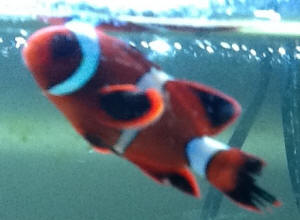
%20clnfsh%20trb.jpeg) |
Sick Ocellaris Clown 12/4/12
Hi Crew. I am contacting you about an Ocellaris clown that has been in
my system for about a year. Three days ago he began acting strangely, he
started hanging around at the bottom of the tank (he usually cruises the
entire tank). The second day I noticed both of his eyes were swollen and
his abdomen was enlarged. I though this was pop eye caused by a
bacterial infection because both eyes were swollen so I began dosing
with a wide spectrum antibiotic (E.M Erythromycin),
<Mmm, antibiotics, antimicrobials... one has to get them INSIDE the
fish... most of the times via food (sometimes by way of injection);
pouring in the tank/system does little good. See WWM re their marine
use/s>
I did not move him to a quarantine tank as he is the only fish in the
system. The medicating has not seemed to help, the problem has only
gotten worse and now he has a growth of millimeter big almost spherical
see through blister like things between the pectoral fin and his body on
both sides, there are a total of about five on each side.
<? Not likely pathogenic, but water quality related, or...>
Water tests showed no ammonia or nitrite and the nitrates are at about
ten. The other critters in the tank are a little zoanthanid
<May be toxifying the system. See WWM re Zoanthid Compatibility>
that hitchhiked in a feather duster worm, two strawberry crabs,
<Predaceous>
some pistol shrimp and a unfortunately healthy population of *Eurythoe
complanata *fire worms.
<Ahh! These are the most likely suspect of the blisters, other "post
puncture" behavior of your Clown>
I have an Aquaclear 100 HOB filter and a currently defunct protein skimmer
that will be back up and running when I get the replacement parts. The
tank is fifty five gallons and has been up for about a half a year. I'm
really stumped about what this could be. Thanks so much in advance. I
have no camera but I can borrow my neighbors if you guys need a photo of
the growths. Sorry about the rambling message.
Much Aloha,
Jacob
P.S might have sent you a message with a duplicate title but no text,
sorry about that
<Didn't have any content, no worries. I'd bait/trap out the Fireworms
(see WWM...). Bob Fenner>
|
Sick Snowflake Clownfish - please help
– 11/19/12
Hi Crew,
<Dez>
I have a black and white Snowflake Clownfish from ORA in my tank.
She has been in there for about 4 weeks.
After about 2.5 weeks of being in my tank, she stopped eating (was
eating 1 mm Spectrum pellets like crazy) and developed rapid breathing.
She became lethargic, went to a back corner, and laid down for days.
Her side had a bulge in it that I am hoping you can see from the
attached picture.
<Nope>
After about 4 days of this, I noticed she had a string of feces attached
to her, about 3/4" long. It remained attached to her for hours,
and finally came out. It was somewhat white. I thought
perhaps she was constipated, and she would get better from having
passed a blockage. But, she seemed not terribly better the
next day, still not eating, still in the back corner.
At that point, my tank manager
<?>
was able to remove her. He put her in a hospital tank
at his home. He used some Epsom salt in the tank, and dosed
some Metronidazole as well. She was better after two
days. She began eating (Spectrum pellets and Sustainable Aquatics
Hatchery Pellets like crazy), swimming normally, breathing
normally. He continued the Metronidazole
for five days
>/// see WWM re... best to only treat once<
and stopped it at that point, seeing she was much better. It
has now been three days later without any medication, and the
symptoms are reappearing all over again. White stringy feces,
rapid breathing, not eating, lethargic. We do not know what
this is or what to do. Hoping you can help us.
Thanks so much,
Laura Garmizo
<With what? Please read here:
http://www.wetwebmedia.com/clnfshdisart.htm
and the linked files above. Bob Fenner>
Fwd: Sick Snowflake Clownfish - please help –
11/19/12
Hi WWM,
Just wondering if anyone had a chance to read this yet...
Laura
<?... B>
|
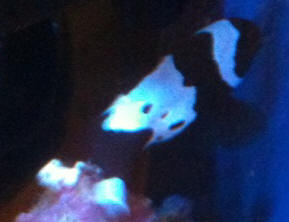 |
|
Urgent Question: Parasite Concern With Clown Fish
11/12/12
Hello WetWebMedia,
<Gerard>
I hope you can help me with my clown fish. I have a concern about potential
parasites with two of my clown fish. One of the Orange & White Ocellaris
Clownfish Tank Bred and one of my Black and White Ocellaris Clownfish -
Tank-Bred. The Orange and White Clown fish has a new spot on its body that I
haven't noticed before. It appears to be a white pimple. It looks raised,
but it is tiny. A little bit bigger than a pin head. I tried to capture a
picture to show where it is but the photo doesn't capture how it is raised.
Any suggestions and course of action?
<Yes; do nothing... the presence of a single spot as you describe is almost
never indicative of pathogenic problems... More likely an "owee" from a
run-in w/ something sharp>
If bad, I hope I have caught it soon enough.
<Will resolve itself in time; likely weeks>
Seeing this, made me begin looking even closer at the other inhabitants.
The rest look good, but I did see a long strand coming from its anus. To be
honest, I have not been looking at their waste very closely, but now since I
am concerned with internal parasites, I have been. I don't have a good
"waste baseline". Is a long strand of waste normal?
<Not uncommon; and again/similarly nothing to panic re>
How can I diagnose if it is worms without a microscope?
<Can't be done as far as I'm aware>
Should I do something with either of them, or should I be watching for a
combination of things before I can act on a diagnosis? I love these guys, so
I hope you can help. <Gerard>
Thanks,
<Welcome. Bob Fenner>
|
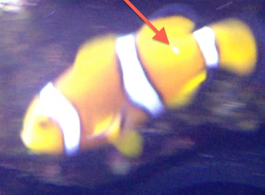
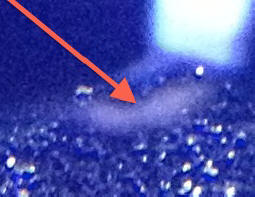 |
Any chance an anemone fish can recover from swim bladder
problem? 10/6/12
Clownfish Sinking - 10/05/2012
Good Evening,
<Good evening!>
I have searched the internet for ideas on treating an anemone fish with
a swim bladder problem...so here I am looking for ideas.
<Welcome.>
There are many sites regarding fresh water fish, but very little
information on treating saltwater fish. (I don't think peas are the
answer for a sinking anemone fish.) The problem fish is an Amphiprion
tricinctus (three band anemone fish) that is over 4.5" long and plump. I
was in the LFS purchasing live brine shrimp (special weekly treat) and
noticed the damaged fish laying on the bottom (on its side) in one of
the many display tanks. Of course, I pointed out the distressed fish and
learned they acquired it when they disassembled a tank for someone who
checked out of caring for their tank. They claimed that the swim bladder
was damaged due to terrible water parameters and owner neglect.
<Unless they have personal knowledge of the history of the animal, then
that is probably just a very reasonable guess. There could also be
illness or even just mechanical damage involved.>
I asked if it would recover and learned that there was a slight chance
but not likely.
<I would've probably said the same.... But that doesn't mean it can't
still enjoy life! If it eats enthusiastically, I say, it should live. I
use this rule of thumb at the lab in which I work.>
The LFS was planning to euthanize the fish that evening (they had it 2
weeks) only due to the fact that no one wanted to put in the effort to
bring it back.
<There may be no "bringing it back", so to speak. But again, if it
eats....>
Well, having a tender heart and a thriving 165 reef tank, the fish came
home with me, for free.
<Good on you, and good on your LFS! Just tell me you quarantined it....>
Currently, located in an acrylic fish trap (12" long, 6" wide and 7"
tall with vents for flow) magnetted to one corner of the 165 gallon.
<Imagine my disappointed face. Stop and think a moment. You brought home
a diseased fish (disease = any state deviating from healthy/normal) and
put it into your thriving home aquarium.... Really, this is not the
safest course of action. But it's done, so let's continue.>
The three band fish eats small sized sinking pellets, Cyclop-eeze, brine
shrimp, Mysis shrimp, and finely chopped silversides.
<A fine diet. If it is happily eating all of these, then I would dare
say it hasn't given up on life just yet! Agreed?>
The fish is a "sinker" and as of day 3, is regaining the ability to sit
on its belly (98% of the time now) and not on its side.
<Very good. It may just be learning how best to cope with its
condition.>
The fish gets very excited at feeding time and will swim up 4" briefly
to feed or it scoots frantically on the bottom trying to eat. (I don't
think the jaw opens properly, as it can only eat small item in relations
to its mouth size) Anyhow, is there a slim chance it will recover with
good water parameters and small/frequent feedings?
<I wouldn't bank on it. But again, that doesn't mean it can't live a
reasonably good life.>
The fish has clear eyes, good fin movement, no damage to fins, normal
breathing, healthy looking scales and some meat on its bones.
<Though it might never regain buoyancy, I see no reason this fish can't
be "happy". Kudos to you for being willing to give him a chance!>
The 165 display houses a pair of clowns hosted by a thriving frogspawn,
a leopard wrasse, a mated pair of Banggai Cardinalfish, a pair of PJ
Cardinalfish, a small red sea sail fin (will relocate to 300 gallon when
larger),
<Very good>
various hermits, snails, peppermint shrimps, brittle star and various
soft, LPS and SPS corals. All other tank inhabitants are healthy and I
have had a long time.
<One last bit of disappointment for putting those animals at risk by
introducing an unquarantined animal.... But I'll stop now, I promise.>
Salinity 1.025, temperature 80 degrees (live in Florida...peaks in
summer at 81 and in January the low is 79), nitrates 0, alkalinity 8,
calcium 440, do you want more?
<All sounds great.>
I do a 20% water change weekly from 2 miles out in the Gulf of Mexico
(been doing this 5 years, no problems so far).
<I prefer synthetic sea salts myself, for the reason of having a "known
quantity", and less likelihood of bringing in something very
unwanted.... unexpected/undetected pollution, toxins, harmful
organisms.... But that's just me.>
I have given my refugium to a school system (I maintain), because I have
a larger refugium in the process of creation.
<Neat!>
An AquaC 240Ev is skimming wonderfully. Orphek LED's are lighting the
whole thing.
<All very good.>
So, is there anything else I can do for the fish?
<Provide it a safe location for it to continue to enjoy its life. Maybe
somewhere where it won't be too far from the surface of the water, or
feed only sinking foods.... Somewhere with either no substrate, or a
very soft substrate, since his skin will be in contact with it almost
all the time - no substrate would be my very strong recommendation.>
Supplements? Raising and lowering the "hospital room" from day to
day-maybe at surface one day, middle the next, and bottom the next?
<I wouldn't do this, except perhaps to first determine which is the most
comfortable for the fish. Once established, I'd leave it there, so as to
not make him have to "figure it all out" again, especially with regards
to distance to the surface.>
Could it live for years sitting on the bottom?
<Yes.>
Once my new refugium is up and running (30 gallons), the anemone fish
could live there in safety.
<A beautiful, perfect option.>
Thank you for any advice or suggestions, Wendy
<Wendy, I'll briefly relate to you a story about a pet female Betta
splendens I had some years ago. She had symptoms of Mycobacteriosis, but
lived for several years despite this. She would alternate between
floating and sinking. I kept her in a long, shallow tank of a few
gallons - roughly 8"x24" in footprint, and just a few inches high - and
had very smooth substrate at the bottom and floating plants across much
of the surface.
That way, when she sank, she was never far from the top (as Anabantoids
breathe air from the surface), and when she floated, she could keep
herself under the floating plants. It worked out well, and she did live
for years.
She had an impressive attitude, too. Also, at work, I work with a
naturally short-lived killifish species. When we have "bellysliders" (a
fish that fails to fill its swim bladder after hatching and thus always
sinks), if there are no other health complications, they can and do
sometimes live every bit as long as their healthy counterparts. My point
is, don't give up on your sinky pal. If she's happy to go on living, you
should go on enjoying her companionship. She is lucky to have found
herself in the care of such a compassionate soul. Best wishes to you and
your pets, -Sabrina>
Clownfish problem, can't find solution, "bloat"
9/20/12
I am having a problem with my snowflake clownfish. I've looked
everywhere for a solution before sending this email and I am hoping that
you can help me to clear it up. My clownfish is somewhere around a year
old and has been in my tank since March. A few weeks ago the clownfish
became very bloated.
<Mmm, a few possible causes... impaction, parasites, genetic...>
After a few days I added Epsom salt and since then have added it an
additional four times. There was a 5 gallon water change in between 2 of
them. The system is 30 gallons total and there is one other tank mate, a
larger Darwin clown that I bought at the same time of the snowflake
purchase. I have not witnessed any bullying at all in fact, yesterday I
saw the little male do the quiver when the Darwin snapped at him.
I feed a varied diet of Marine S, Tetra flakes, and Marine cuisine. The
past week I have thrown peas in there a few times to try to clear the
blockage.
<Assuming there is such>
I am now beginning to wander if it is blockage at all and not a parasite
(worms etc).
<Not common in cultured individuals (vs. wild-collected)>
He eats anytime i feed which is now every few days because i don't want
him popping (I know this may sound stupid but he is that big), he
doesn't swim like anything is wrong, in fact i would never know anything
was wrong if he didn't look as though he ate a marble. We are on week 3
I think and a few times the swelling has gone down (a little bit) but
then comes back a when i feed. Any help would be appreciated, I'm
stumped.
Thanks
Steve
<Mmm, a bath or continuous emersion (only w/ this antibiotic, as others
may kill off nitrifiers, and not in the presence of Cnidarians) w/
Oxytetracycline may prove efficacious... 25 mg./gal. and 250
respectively... Otherwise, just time going by... Bob Fenner>
Re: Clownfish problem, can't find solution
9/23/12
I am not familiar with Oxytetracycline. Is it the same thing as T.C.
Tetracycline?
<Mmm, no... search both on the Net>
What is your opinion on API General Cure?
<For what purpose/s? Mainly useful for external flukes... B>>
|
Ocellaris Clownfish, hlth. 8/8/12
Hi!
I hope you can help. I have 2 clowns (they've been in hypo-salinity
<Not advised for Amphiprionines, or other fishes that live in close
association w/ invertebrates that also don't tolerate low Spg>
QT for 6 weeks so far because they got Ich when I first got them), they're
both basically the same size, they do fight, but I'm hoping they'll
establish their pair before the lesser one is a goner. Anyway, the one that
seems to be the one to stay male, since i got him has had this 'cracking' on
him. It was only a bit when i first got him, and it has expanded to both
sides, and longer lines. Have any idea what it is? I've attached a photo,
he's not dead! Just a quick snap while I was taking them out for cleaning
the QT.
Thank you!
<These fish need to be returned to normal water density. Bob Fenner>
|
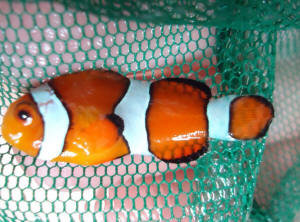 |
|
Re: Ocellaris Clownfish 8/9/12
I read online to do hyposalinity for Ich for clowns?
<? Not on WWM>
You're saying copper should have been done? It was like this when I saw him
at the pet store, just has gotten more/longer. I've started slowly raising
the salinity, to be normal by the 8 week mark. Like instructed. You didn't
answer my question, what's the issue with him?
<Don't write... Read. B>
|
Clownfish Dying? 4/26/12
Hi CREW, been a long time.
<Hello Debi>
We're running an 180 gallon FOWLR and our true Percula clown is
obviously not feeling well. She was almost full grown when we got her
and we've had her well over 6 years now. We are totally stumped as to
what is going on with her? We are honestly wondering if she might be
dying of old age or some internal problem which is not able to reveal
itself (i.e. like a swim bladder problem).
<I'd rule out swim bladder based on your description.>
About 4 weeks ago she took to staying in one corner away from the other
fish. At that time she would briefly join in during feeding time, then
back to her corner. She paid a visit to our cleaner shrimp and didn't
look like they found anything. The good news in this, all her tank mates
are very peaceful and easy going, leaving her alone.
Well, except the Foxface.
The two have been tank mates for a long time, so he has come to check on
her. He comes up very slow and delicate as if to say "what's up with you
girl?".then he'll wonder off.
A couple of times he coaxed her out to eat like he really cares about
her but it's obvious she wants to be left alone.
Her colors have remained as brilliant as ever except now at the end of
her tail, the black at the very tip looks faded. There are no signs of
any disease none! She's not gasping she just seems weak. A reputable
reef shop tested the water and it tested fine but suggested we double
our regular water change just to make sure there wasn't something up
with the water that wasn't working for her.
They told us to increase the oxygen to the tank and sent us home with an
immune booster to add to the water to see if that would perk her up. We
also bought some food they said is hard to resist even when fish are
sick. Whatever is going on, she has not resumed normal behavior but will
have short spurts of coming out for a swim, then back to recluse. We
were told not to try and medicate her because that could do more harm
than good without any visible signs of a disease.
<Good advice.>
They also suggested we don't try to move her out of the tank because all
the fish are respectively leaving her alone and letting her rest herself
without any stress. Our regal tangs are a nice marker all is well with
the tank. They are dark cobalt blue with no fade which is usually a very
good sign. Overall, all the other fish are enjoying life as usual. Have
any ideas what might be up with her?
<Since you have had her for six years and was almost full grown when you
got her, I'd say old age may be taking it's
toll unless an internal disease exists.>
Gratefully,
<You're welcome. James (Salty Dog)>
Debi
Platinum Clownfish Bloated. 4/10/12
Hey guys,
<And gals Aly>
I have searched through forum after forum and can't seem to find an
answer as to whats going on with my Clownfish. A little history first.
I have a 14 gallon tank with 2 small platinum
clownfish, a barnacle blenny and quite a wide variety of
shrimp including harlequin shrimp as well as your usual assortment of
hermit crabs and snails. My tank has been running for over a year now
and receives water changes every week to 2 weeks. I'm not sure the
amount of the water change or the levels in my tank as my boyfriend
does this and checks everything for me while he tends to his much
larger tank as well. I also have a wide variety of corals in my
tank
<Mmm>
and recently changed the rock work around to accommodate more
Zoas.
<These especially>
That was about 3 weeks ago.
During that time I removed the fish and did not return them to the tank
for a couple of hours and that night a water change was done. I have
had this pair of clowns for about 6 months now.
The clownfish in question is the smaller of the 2 and had
originally lost all color when I had put him my tank.
<A good clue>
He stayed relatively colorless for months but he was eating fine
and swimming normally. I attributed it to the constant bullying of the
larger clownfish (although no physical fight ever ensued). As time wore
on he regained color to his fins and face until a few days ago when I
noticed his color fading away once more. More disturbingly then that
yesterday he looked like he had just eaten a huge meal. We don't
feed the fish till later in the night so I knew this was not the case.
I looked on the forums and some people are saying not to feed such a
meaty diet. We feed Mysis, Cyclops, marine cuisine, bloodworms
(although the clowns don't eat them).
<Then delete from the diet>
On any given day we just pick 2 and that's what they have for
supper. Even though he was bloated he still ate perfectly fine
yesterday. Today he has spent the whole day swimming in the left corner
of my tank facing up although he does come to the glass when he
see's me. Which leaves me to believe that his belly is not full of
air because everyone seems to describe their fish swimming downwards or
they float to the top. Is it possible that I have brought some sort of
parasite in off a chocolate chip star fish that I feed my shrimp?
<Mmm, is a possibility, yes; but unlikely... Both clowns would be
affected>
I really have no clue. The other fish in my tank seems happy and
healthy with beautiful color and slim figure. Please help. I am really
fond of this little guy and would prefer if he did not die.
I could not get a quality picture watch the video in the link. I took a
short video of his behavior and belly so you can get the full
picture.
http://www.youtube.com/watch?v=-oOkwRhEuqk&feature=youtu.be
Cheers
Aly
<And you... I suspect the stress of being crowded, bullied as you
state, and the presence of the Zoanthids (chemical fighting w/ other
Cnidarians: http://www.wetwebmedia.com/ZoCompF3.htm)
are all contributing causes... If your boyfriend's tank will
accommodate this small Clown, I would move it there. Bob Fenner>
|
Maroon Clownfish 1/28/12
Hello crew, Jake here! I hope your having as great of a day as i
am!
<I hope you are>
The reason i am writing you, is because I'm having some
thought about my recent addition to my tank: a small ORA Yellow
Striped Maroon Clownfish.
I got him as a replacement to my poor Perc that i lost a few
weeks ago do to a powerhead malfunction. I got him because he was
a bit smaller, and that's what i was looking for, he seemed
like he was in good health and the shop owner has had him for
several months before i got him and said he was eating well. Its
been a day or so, and after some serious inspecting of him, he
doesn't fit the normal profile of a Maroon Clown,
<No... has genetic issue/s>
or so i think. He small, only about a inch and a half, and he has
a body shape much like a Perc clown, but he is a deep red, almost
brown in color with a few small patches of lighter orange, and
his stripes are white as far as i can tell.
I did not notice this because the glass on the tanks at the store
are tinted ( i think ) ad throws the colors off. I'm
wondering if he may not be a Maroon at all.
<Is a Premnas; just diffed>
Ill attach some pictures, although he didn't make it easy
getting some pictures that were not a total blur. If you could
lend a hatchet to my intellectual thicket, that would be
amazing.
Once again, thank you crew!
<Read here: http://www.wetwebmedia.com/maroonclnart.htm
the linked files above; and search WWM w/ the string
"Clownfish Genetic Disease"
Bob Fenner>
|
|
 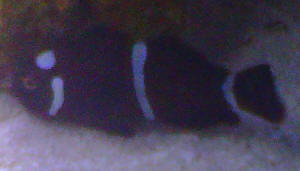
Maroon Clownfish Follow up, genetic
issue/s 1/31/12
Hey Bob, thanks for getting back to me so quickly!
<Welcome>
I'm having a hard time locating the information on Clownfish
Genetic Diseases. If you could just relay the information about
it to me directly, or perhaps give me a straight link to the
page, that would be great. Is a genetic disease like this common?
Will it affect life span / longevity?
<Was very common two-three decades back when Clown breeding
was in its heyday... Don't know specific references (try the
search tool on WWM), but the pix you sent do show this specimen
to be deformed... Such individuals should really be destroyed...
As yes, they very often don't live well or long. BobF>
<<<<<Thanks so
much,>>>>>>>>
Jake
Re: Maroon Clownfish Follow
up 1/31/12
Little harsh don't yeah think?
<Mmm, no>
Because of theological reasons i have to value all life,
including the genetic unfortunate, while i realize his
days may be numbed, my course of action will be to, medicate and
nourish to provide as best a home as i can to ease what time he
has left and enjoy his presence in the tank. If you do stumble
about any information on the matter please write back as i will
be interested to hear.
Thanks for the swift replies Bob,
J Larson
<I too value all life. B>
|
|
|

